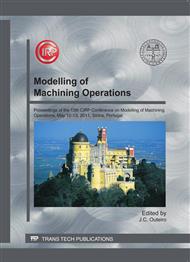p.579
p.591
p.600
p.610
p.622
p.632
p.642
p.652
p.662
Fixed Boundaries Receptance Coupling Substructure Analysis for Tool Point Dynamics Prediction
Abstract:
In many applications, chatter free machining is limited by the flexibility of the tool. Estimation of that capacity requires to obtain the dynamic transfer function at the tool tip. Experimental calculation of that Frequency Response Function (FRF) is a time consuming process, because it must be done using an impact test for any combination of tool, toolholder and machine. The bibliography proposes the Receptance Coupling Substructure Analysis (RCSA) to reduce the number of experimental test. A new approach consisting of calculating the fixed boundary dynamic behaviour of the tool is proposed in the paper. This way the number of modes that have to be considered is low, just one or two for each bending plane, and it supposes an important improvement in the application of the RCSA to the calculation of stability diagrams. The predictions of this new method have been verified experimentally.
Info:
Periodical:
Pages:
622-631
Citation:
Online since:
April 2011
Authors:
Keywords:
Price:
Сopyright:
© 2011 Trans Tech Publications Ltd. All Rights Reserved
Share:
Citation:


